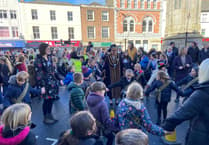LOCALS and visitors are invited to step back in time with Dingles Fairground Heritage Centre, as their new exhibition takes people through times past to the sombre days of the First World War to give an insight into the rarely seen showmen’s war, writes Rosie Cripps.
Dingles Fairground Heritage Centre, just outside Lifton, showcases the quirky, old and amazing fairground rides, games and heritage from the past.
Its new exhibition, The Showmen’s War, highlights a time during the First World War, where showmen fought alongside other soldiers, where the people of the business would fundraise vigorously to feed troops and provide more medical services, and where they too would suffer at the hands of a 20th century tragedy.
People are often taught about the woeful days in the trenches of France during the war — boots sodden in mud, rats, rain, the never-ending threat from the trenches across the front and a deep longing to be home — as well as the thousands of women taking on jobs at home, signing up to nurse wounded soldiers, and more.
However, little is told about the minority groups that contributed great amounts to the war efforts, and sacrificed their lives and businesses.
Last week, Dingles held a first-peek event into The Showmen’s War exhibition, and Nick Sturgess, curatorial manager at Dingles Fairground, was excited to see what the afternoon would hold.
He told the Post: “We want to make it known that the showmen also made a huge contribution to the war — we want that to be understood and explained, and tell that side of the story. You don’t often hear this side of what happened.”
Dingles received a grant from the Heritage Lottery Fund last June, which has enabled them to gather stories, photographs, information and exhibits to display for the season. The attraction reopened last Friday, March 16 and the exhibition will run until October, when the centre will close for the season.
This exhibition also ties in with the centenary of the end of the First World War — an incentive for this particular exhibition’s theme.
Visitors to the event were given the opportunity to browse the wide variety of pieces in the huge warehouse. Music from times past, such as It’s a Long Way to Tipperary, rang out in the charming fashion of the fairground; colourful lights shone bright and beautifully-painted merry-go-round horses stood proud as they would have when they were first built.
Chairman of the fairground heritage trust, Richard Sandercock, said: “It’s a shame about the weather today, but it seems somewhat appropriate as Ypres was probably the same.
“A huge amount of work has gone into this, and I think it’s rather wonderful. Our chairman of the national Showmen’s Guild has travelled all the way from County Durham today, and it’s fantastic to have him here.”
Nick added: “It’s been a bit of a worksite over the last few months. I’ve been curator here for two years now, and as someone who is from outside of the fairground community, I can now see how it’s such a wide community and how it affects the every day lives of people involved.
“This year is the centenary of the end of World War One, and we want to tell the story of the travelling showmen and the war — it’s a story not many people have heard of and it’s not really known about. Thanks to Heritage Lottery Fund, we have been able to create this exhibition.”
Stephen Smith, vice-chair of the fairground heritage trust, said: “This is the first time we’ve put on an exhibition of this kind, and we thought the First World War would be the most appropriate theme to put on for this.
“We have got creditation this year, so in the future we can hopefully afford to do more exhibitions like this. This has to be preserved, and I think this section of the war gets ignored far too much. We’ve got to pay tribute to these people.
“Many had to close their amusements, and there were no thoughts as to how these people would make a living. Showmen also paid an absolutely fantastic contribution to the war, and we now know that around 100 showmen paid the ultimate sacrifice. This exhibition pays tribute to them.”
Among the main exhibits are a reproduction of Edwin Lawrence’s ‘The Kaiser’s Ass’, which Nick gave a demonstration of earlier in the event.
A typical form of British propaganda during the war, the throwing game illustrates a cut out of John Bull (the national personification of the United Kingdom) with a stick, with the German Kaiser sat on a donkey. For those wanting to play the game, they would reach into a pot for a heavy ball and aim it into one of the two holes above the Kaiser and British man. If the ball hit the hole on the left, the donkey would tilt forward to ‘buck’ the Kaiser off, and if the ball hit the hole on the right, the British man would swoop and kick the donkey on the backside.
Also featured is a reproduction of a fairground war tank, which would have been situated on a roundabout, allowing more than 14 people to sit in velvet-covered seats in the tank — another form of British propaganda.
There was also an American-build FWD lorry, used for the British war effort. After the war, the government sold hundreds of these lorries off to fairgrounds. This particular one at Dingles was used to carry the ‘Gallopers’ victory horses for the merry-go-rounds.
John Culine, Showmen’s Guild president, shared a more personal story about the war.
With his family line having a background in the showmen industry for generations, this exhibition was one Mr Culine was very passionate about. He reminded the audience that showmen are not ‘that type with the fancy weddings’, often seen on television.
“When the men went off to fight, the showmen put a collection together and raised thousands for a buffet for the soldiers, and made sure they got something to eat. They then thought about buying an ambulance, so put pleas out to buy an ambulance. They didn’t buy one — they bought 12! Some went to the Western Front, and some went across England. They provided holidays and entertainment for the kids and families left behind. In World War Two, they raised £3,000 in just over 12 months to provide a Spitfire.”
Mr Culine, from Durham, then delved into a personal family story, detailing how his father’s eldest brother had gone missing during the First World War, and how he had done lots of research into his missing uncle’s whereabouts.
“My Uncle William was called up in 1916, and after being sent to his barracks, he was shipped to France. All of his letters were buried with my grandmother, except for two. One was asking to give little Cliff — Clifford, my dad, who was only about seven at the time — ‘a kiss from me’, and the other was a letter stating that my uncle had been wounded in Merville in April, 1918.
“The family had hoped he would have been taken prisoner, but for 78 years, he was missing. No-one knew what had happened to him — except for my grandmother, I think she knew eventually — so when the letters came into my possession, I did a bit of research. I spoke to the relevant people, and found out that my uncle had died on April 12. He had been wounded and identified as dead when he was found, and he now lies in an unmarked grave in Merville.
“I know he was in the number one platoon of the Durham Light Infantry, he went to France and was left with the company commander. He died sometime between 12am and 1am on that morning of April 12, and crossed the last bridge because Merville was being evacuated. Someone from the platoon had said he had seen him wounded, but they couldn’t stop for him.”
Mr Culine explained that he travelled to Merville in France after discovering more about his Uncle William, and that he found an unmarked grave in the Durham platoon’s memorial, stating ‘Died’ on the stone.
He said: “I looked at it, and I knew that that was my Uncle William. I’ve lived and breathed the First World War, and you don’t know how it feels for me to be here today in this fairground museum. I’m extremely proud to be president of the Showmen’s Guild, and I’m extremely proud of all of those showmen who sacrificed their lives during the war. It’s all preserved and it’s in here and it’s wonderful.”
During the First World War, show people tried to keep the country’s fairs open as usual, but with the new threat of Zeppelins in the air, this would go on to affect the business.
In October 1914, Hull Fair went on as usual, promising ‘to be almost as huge an affair as ever’. However, come 1915, the bright lights of the fairs, a great attraction, became an increasing risk to people’s safety and in June of that year, John Murphy’s scenic railway was destroyed at South Shields due to an air raid.
It became almost impossible for fairs to open after dark, so many towns and cities came to the decision to not hold fairs for the duration of the war.
As the war continued, it became difficult to find men to work at the fairgrounds and shows, so women took their places in the running of the businesses. Showmen contributed in a variety of ways to the war efforts — serving at the front, manufacturing weapons and ammunition and transporting war goods and food, amongst other things.
Dingles Fairground Heritage Centre is now open until October. To find out more about the centre and the exhibition, visit http://fairground-heritage.org.uk/




